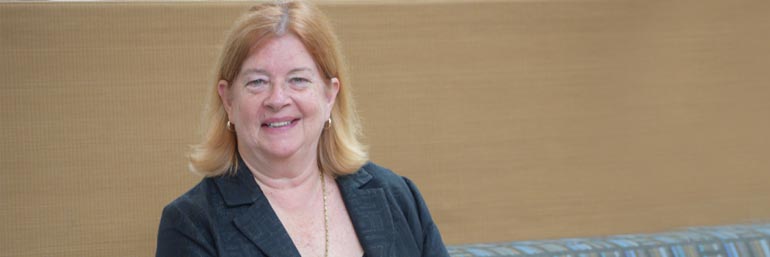Jul 25

Teaching Students the Best Ways to Ask: Karen Gil, Ph.D.
After 18 years of teaching medical interviewing skills, Karen Gil, Ph.D., has figured out any number of ways for first-year College of Medicine students to skillfully direct patient interviews and demonstrate that they’re listening.
Dr. Gil, an encouraging listener herself, says the most important part is that students learn how to empathize with patients, rather than sympathize. Instead of saying, “Oh yeah, I’m so sorry,” she teaches students to respond with an answer like, “You’re telling me that if you have strep throat, you’re going to miss more work and risk getting fired?”
A professor of obstetrics and gynecology and scientific director for Summa Health, a Northeast Ohio Medical University partner hospital, Dr. Gil has helped over a hundred students evolve and develop through the one-year Foundations of Clinical Medicine course. She was recently awarded the Foundations of Clinical Medicine Course Excellence in Teaching Award by NEOMED’s Department of Family and Community Medicine.
Throughout the year, those Foundations of Clinical Medicine students conduct interviews with coached patients or standardized patients in the Wasson Center for Clinical Skills, then review each student’s interview video in class. Doing so gives Dr. Gil and members of the class a chance to provide constructive criticism. Dr. Gil likes to refer to the course as an “instructor-led, team-based” approach.
What’s the difference between coached and standardized patients? A coached patient is someone who has been given a general idea of an ailment or concern to present—like a psychosocial problem that is personal, but nothing too intimate, says Dr. Gil. A standardized patient has a story. They follow an assigned script, then leave time for each student to converse and gather basic medical information.
Speaking from first-hand experience
Dr. Gil has always been confident in her students, but a particular visit to Akron Children’s Hospital, also a NEOMED partner hospital, with one of her sons a few years back made her beam with pride.
“I had a fourth-year College of Medicine student interview my son and me before an asthma assessment. He walked us through a number of questions—everything from my son’s past medical history to our home life. It worked perfectly! When I left, I said to the nurses, “I teach that! He could have been my student four years ago,” says Dr. Gil.
Lo and behold, it was that student’s first day on his pediatric rotation. Dr. Gil was gratified that the student’s NEOMED training allowed him to walk into a strange place and seamlessly conduct an interview.
Practice makes progress
How can a skill as simple as medical interviewing determine the future success of students?
It’s actually not a simple skill, but one that needs to be learned and practiced.
“You might hope that on a rotation like anesthesia or pathology, students will learn what they need to learn. As for medical interviewing skills? We don’t have to hope. We know our NEOMED students can go out and run a first-class interview where the patient will trust them, have faith in them, believe in them and share important information so the doctor, medical student or resident can take care of them,” says Dr. Gil.
Streamlining processes
Aside from teaching medical interviewing skills, Dr. Gil has teamed up with the Office of Research Sponsored Programs to create a process that helps researchers determine whether their studies are research, quality improvement or program evaluation.
A researcher herself, specializing in quality of life in women diagnosed with gynecologic cancer, Dr. Gil recently gave a presentation titled, “Research, Quality Improvement and Program Evaluation: What’s the Difference and Who Cares?” It’s not always clear which category a project falls under. “Sometimes it’s fuzzy and complicated, but you better get it right,’’ says Dr. Gil. Research, for example, is regulated by the federal government and requires Institutional Review Board (IRB) approval.
Dr. Gil figured that somewhere, another university had probably found a way to simplify the determination process. She tracked down a good model being used at the University of Wisconsin, then led the detailed work of tailoring it to NEOMED’s specific needs. Now, both NEOMED scientists and the Office of Sponsored Research—which is responsible for making sure that they comply with the agreements—can much more easily make a determination.
Working towards a better future
Whether she’s teaching students how to conduct interviews or simplifying research processes, this devoted faculty member is surely leaving her mark on the University.
“I love NEOMED. It is a fantastic place. The University has a spectacular emphasis on medical interviewing, quality care, compassion and competency, says Dr. Gil.
“It has its priorities straight.”


